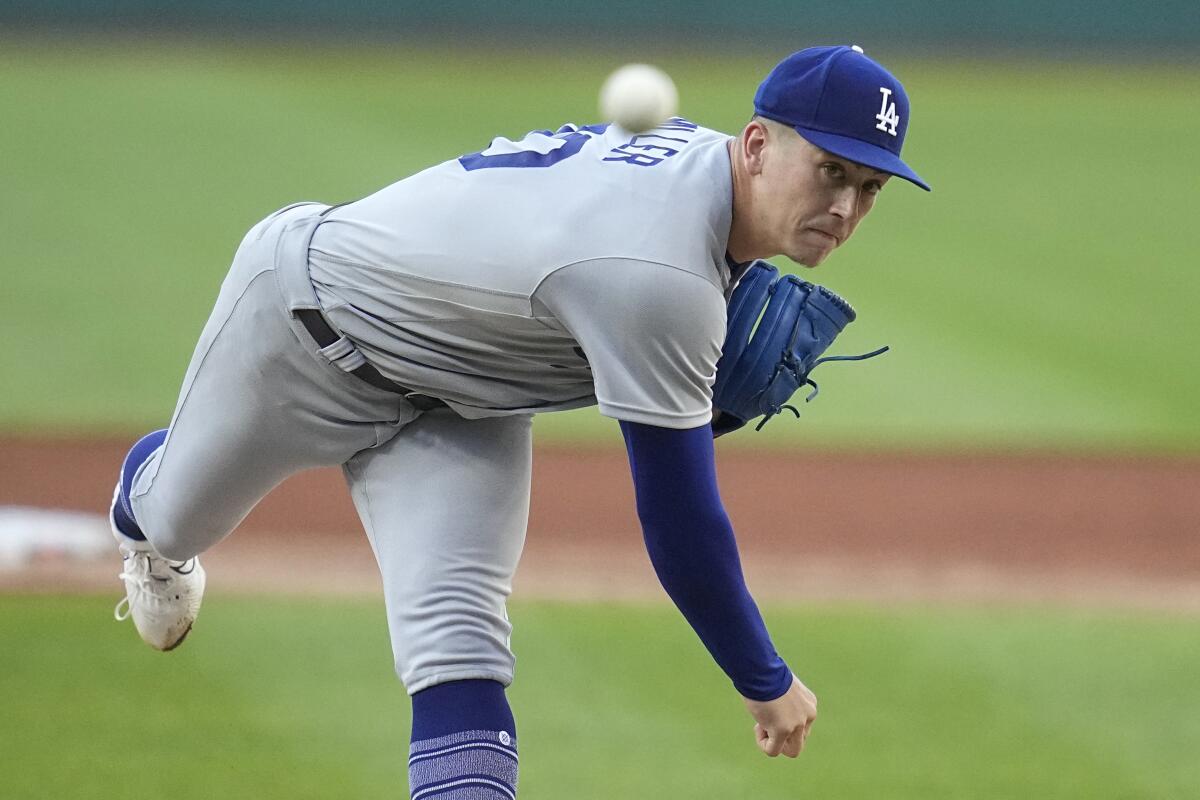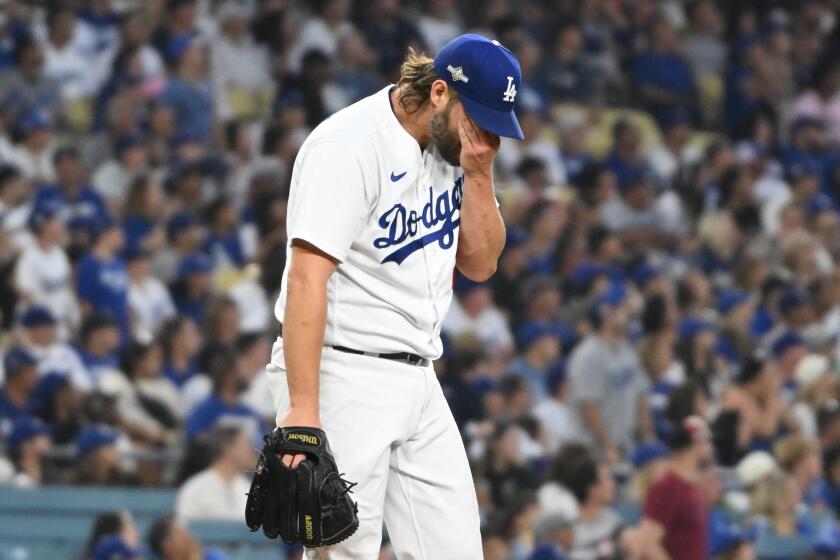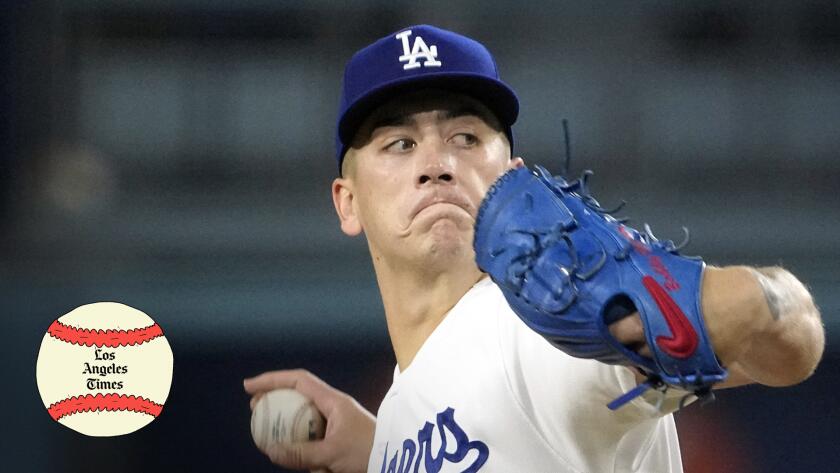Emotional control: How Bobby Miller’s rookie growth earned Dodgers’ playoff trust

- Share via
Dave Roberts delivered the initial message.
Lance Lynn made sure to hammer it home.
After watching an amped-up, and at times over-hyped, Bobby Miller navigate a laborious four-inning start in San Diego in early August, both Roberts, the Dodgers’ manager, and Lynn, their veteran trade-deadline acquisition, came to the same conclusion about the team’s rookie star.
Miller had the stuff to be a viable postseason starter.
But, more than two months into his debut campaign, he needed to home in more emotional control, too.
The Dodgers ace has had his share of bad postseason appearances, but nothing was as poor as what he delivered Saturday in a blowout loss to the Diamondbacks.
So, after that San Diego outing — in which a fiery Miller romped off the mound after escaping several early jams, but also seemed to run out of gas in early innings — Roberts and Lynn had conversations with the 24-year-old pitcher.
“Me and Lance, we double-teamed him,” Roberts recalled last week with a laugh.
“We had a good conversation,” Lynn added, coyly. “He’s just becoming his own person. That’s what it’s all about.”
Whatever they said, it worked.
Two months later, the Dodgers are not only entrusting Miller with a playoff rotation spot, but they are also counting on him to help them get out of their National League Division Series hole against the Arizona Diamondbacks.
“It’s an honor to have the trust by the coaches and the teammates to put me out there in Game 2,” said Miller, who will start Monday night at Dodger Stadium with the Dodgers trailing 1-0 in the best-of-five series. “I feel ready to go.”
For Miller, the former first-round draft pick who went 11-4 with a 3.76 ERA in 22 starts as one of the majors’ better rookie pitchers, it will be the culmination of both a slow-burn developmental process and a crash course at handling big-league stardom.
He has worked for years on perfecting his arsenal, which includes a 100-mph fastball, wipeout changeup and a variety of other breaking pitches.
But it’s only been this season, his first in the majors, that he has learned to handle the mental strain and emotional grind of an MLB campaign as well.
“Obviously it’s a little more important,” Miller said. “But just treat it like a normal game. Don’t change myself. Don’t change who I am. Just be the same pitcher I’ve been this last month or so.”
- Share via
The hard-throwing, highly touted prospect hardly disappointed when he was first called up in late May.
He pitched five strong innings in Atlanta in his debut. He was 3-0 with a 0.78 ERA through his first four starts. And by the end of July, it was clear he’d be in the rotation for the long haul, giving the Dodgers some much-needed length in a season in which only one member of their opening-day rotation (Clayton Kershaw) made it to the end of the year.
“I think he’s done tremendous,” pitching coach Mark Prior said at the time. “We’re counting on him to be one of our mainstays, and he’s performed.”
Still, Miller seemed to overexert himself on occasion. His emotions could swing from anger to relief in the span of several pitches. His intensity would spike in the face of pressure situations or missed ball-strike calls. When his adrenaline shot up, his stamina on the mound would sometimes go down.
The August outing in San Diego offered the most telling example.
After stranding runners in scoring position in each of his first three innings, Miller flexed, fist-pumped and flounced his way off the rubber. It wasn’t a problematic or disrespectful display. But it didn’t escape Roberts’ eye, either — especially after Miller seemed to run out of gas while giving up two runs in the fourth.
“When I see a fist bump in the second inning, that’s telling me that adrenaline is already being tapped into,” Roberts said that night. “He’s gonna go out there and compete. And I’m sure he felt like he had more in the tank, which he should. … It was still a good outing for Bobby, but I still feel like there’s some growth in there.”
Lynn, who had been traded to the Dodgers only days earlier and was watching Miller pitch for the first time, agreed.
A fiery mound presence in his own right, the 12-year veteran reinforced Roberts’ message by emphasizing to Miller the importance of emotional control. After all, it’s fine to get amped up on the mound. But over the course of a full season, Lynn knew such intensity needed to be properly channeled, too.
“He’s a high-energy guy, a super big competitor,” Miller said of Lynn. “So I asked him how he handles those moments, and he gave me his feedback.”

Then, Miller went about trying to enact immediate changes.
In the same way he learned to take bullpen sessions more seriously in the spring, and embraced the challenge of game-planning for big-league opposition over the summer, Miller tried to refine his in-game demeanor.
There was a lot of “self-talk,” he said, making a conscious effort to calm himself down in the middle of outings.
He also put a renewed emphasis on consistent execution — narrowing his focus in stressful sequences to staying in his mechanics and finishing pitches.
“Forget about everything else, and this pitch, right now, execute it,” Miller explained. “It’s easy to say. It’s a lot easier said than done. … But recently, I’ve been executing a lot more. And I’ve been taking a lot more pride in execution over all other stuff.”
Indeed, improved results quickly surfaced.
After averaging just over five innings per start before that San Diego outing, Miller pitched into the sixth inning in the next 10 games, a streak snapped only by an intentionally shortened four-inning outing in his regular season finale last week.
Over that span, Miller gave up more than three runs just three times, allowed opponents to bat just .201 against him, and cemented his place in the Dodgers’ October plans, entering the NLDS as their most built-up starting option.
“You just see the growing process,” Lynn said. “I’ve been around some good ones, and he’s right along with them. For him to take that step has obviously been huge for that group, with the injuries and everything that’s gone down. So obviously, the growth is great.”
The pitching staff’s other resident veteran was equally impressed.
“He’s doing a better job of that, controlling his emotions in the inning and taking it, as cliched as it sounds, one pitch at a time,” Kershaw said of Miller. “Getting super high after an inning, or getting super defeated after an inning, it kind of drains your energy. … Those big emotional runs take it out of you. So you just gotta try to stay within it as best you can, and you can relax after it’s done.”
Monday’s outing will be Miller’s biggest test yet.
After Kershaw’s one-out, six-run debacle in Game 1, the Dodgers are facing an unexpected deficit in their best-of-five series.
The Dodgers have been known to be hitters this season, but after mustering just four hits in Game 1, they could see another early winter if the bats don’t come alive in the NLDS.
Their already shaky pitching postseason plan, which might not include any traditional starters beyond Miller and Kershaw, is in danger of a sudden collapse.
Thus, it will be up to Miller — in what is certain to be the biggest game of his life — to keep his cool and spearhead a response.
“Knowing there was a potential that he could be a big part of this [postseason], he had to be able to manage that,” Roberts said of Miller’s recent maturation.
Then, when asked if he was excited to see how Miller will embrace the postseason stage, the manager quickly flashed an eager grin.
“I am,” Roberts said. “He’s gonna be great.”










